If you’re new to search intent, the idea may sound odd at first. How can you know the intent behind a search query?
And how can you “satisfy search intent?” Why can’t site owners simply focus on creating quality content?
The answer to these questions is hidden in plain sight.
As you’ll learn, clues to search intent are all around us. And creating content to satisfy that intent is surprisingly simple.
Even so, most site owners disregard search intent. Their oversight creates an opportunity for you.
So, let’s take a closer look at search intent.
What is Search Intent?
Search intent (also known as user intent or keyword intent) is the goal or purpose of a query searched by the user. It’s basically identifying the user’s intention when they type in a specific keyword.
There are two key aspects of search intent.
- Search queries (also called keywords)
- And search engine results pages (SERPs)
Both yield essential clues.
Let’s start with search queries.
Search Queries
For each search query entered into Google, we can understand something of the user’s intent.
Consider these search queries: what do you think the searcher wants?
- korean taco delivery near me
- 24 hr plumber boston
- what is boxing day?
- prevent pipes from freezing
- birdseed with peanuts and cherries
Not all search queries are so specific. Many are vague. For instance, what can we conclude about user intent for the term “insurance” or “English literature?”
Not much!
Often, the more specific the search term, the clearer the intent.
Search intent is like a customer saying what they want out loud. Some customers aren’t sure what they want. Others know exactly.
Imagine 3 customers walk into a hardware store. Each is greeted by an employee asking, “What can I help you with?”
- Customer #1 says, “Tools.”
- Customer #2 says, “My faucet’s leaking.”
- Customer #3 says, “I’d like a 40-piece socket set. Have any on sale?”
Customer #1’s intent is vague. Customer #2 has a problem but doesn’t know how to solve it. And Customer #3’s intent is clear.
The hardware store employee will need to ask Customers #1 and #2 some questions to understand better what they need.
Search engine algorithms act like store employees or librarians. If a search term is vague (like “tools”), the search engine will present options like
- Used
- Under $80
- Nearby
- Get it fast
- Electrician
- On sale
These options help the searcher narrow down what they want.
Content creators serve the same function. They may take a vague search query (like “My faucet’s leaking”) and create an article to help the searcher fix the problem.
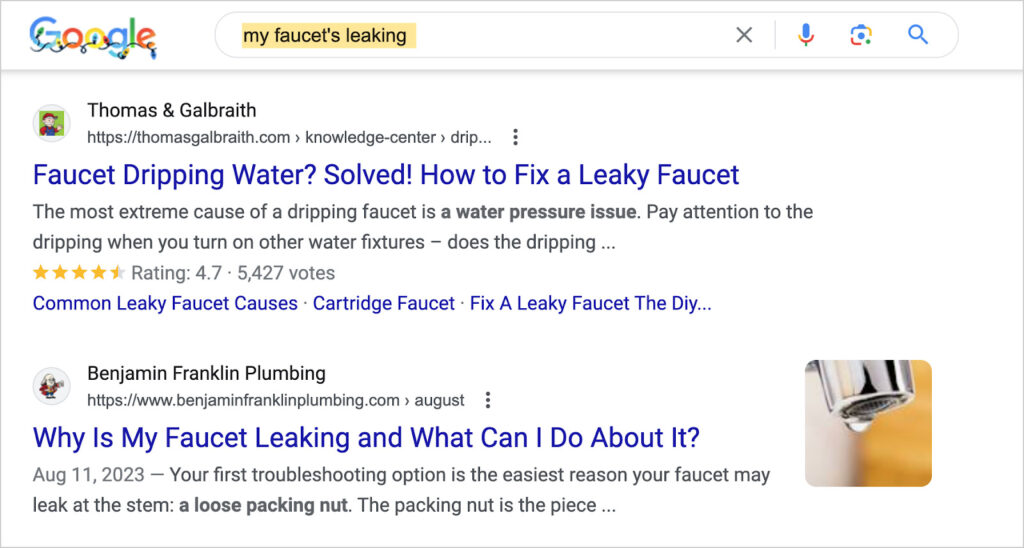
And when search intent is specific, as with “40-piece socket set on sale,” Google knows exactly what type of options to show the searcher.
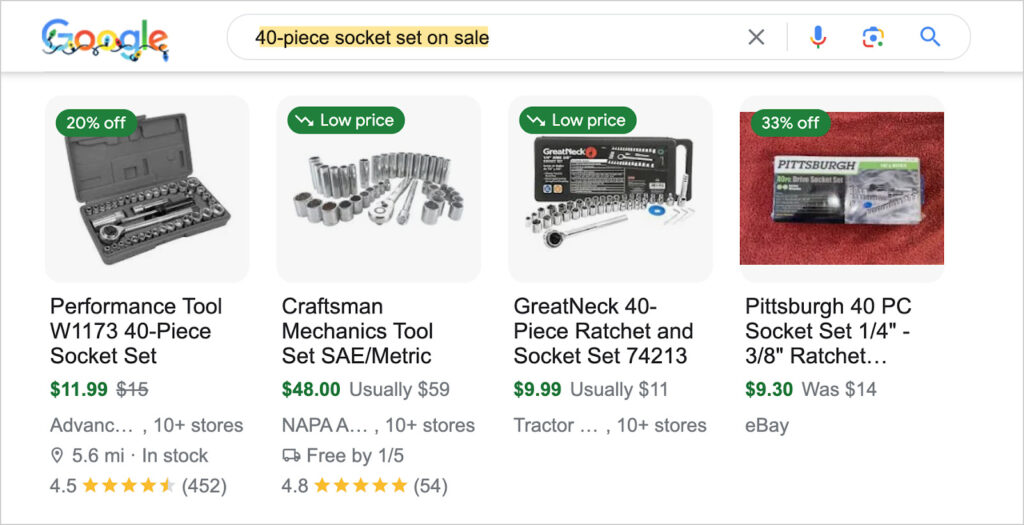

The results in the image above are from businesses. Even though they look like ads, they’re not.
Notice how each item caters to the searcher’s desire for a discount?
Now that you understand how search queries signal intent, let’s discover what can be learned from search engine results pages (SERPs).
Search Engine Result Pages (SERPs)
Remember: Google’s goal is to satisfy searcher’s intent by providing helpful, relevant content in response to search queries.
This is where search engine rankings come in. The more helpful, interesting, or insightful a web page is to the user, the higher it will rank.
The pages that rank high provide essential clues about the type of content that will satisfy searchers.
Remember: a web page ranks in relation to a keyword. This is why people create content based on a keyword: they want to gather information about search intent first because they know that will help their article rank.
Let’s get hands-on to see exactly how this works.
For example, we’ll search Chrome Incognito for “best WordPress form plugins.” Imagine we’re considering creating an article that targets that keyword.
Should we do a review of our favorite form plugin? Should we publish a page of mini-interviews with business owners and ask them what form plugins they use?
The search results will help us plan what type of content to create.
Looking at page 1 of search results, what can we discern about search intent?
Almost every high-ranking web page is a list of recommended WordPress form plugins.
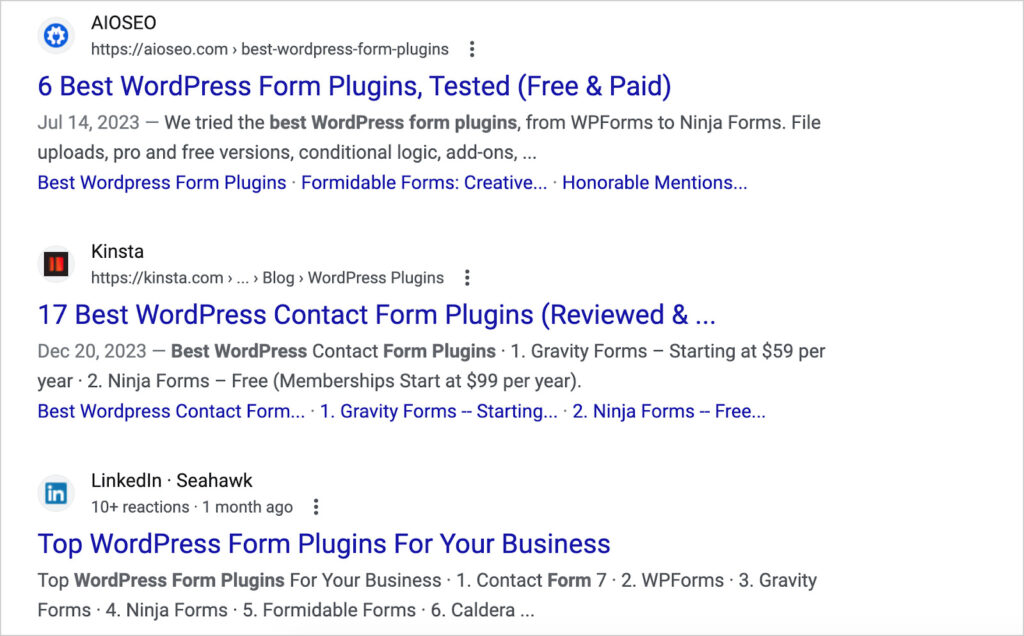

Because Google rewards articles that best match search intent, we can conclude that what users want when they search for “best WordPress form plugins” is to compare form plugins so they can pick a good one to buy.
We can say:
- Those who search for “best WordPress form plugins” have buying intent.
- They want to compare the features and prices of the top-form plugins.
To the degree that your article helps searchers do that, it will rank well.
People Also Ask Questions
You’ll find more clues by reading the People Also Ask questions in search results.
PAA questions don’t appear for every search query, but they do for many.
These are the most common questions that searchers have on the topic. So, answering some of these PAA questions in your article can help you meet search intent for that topic.
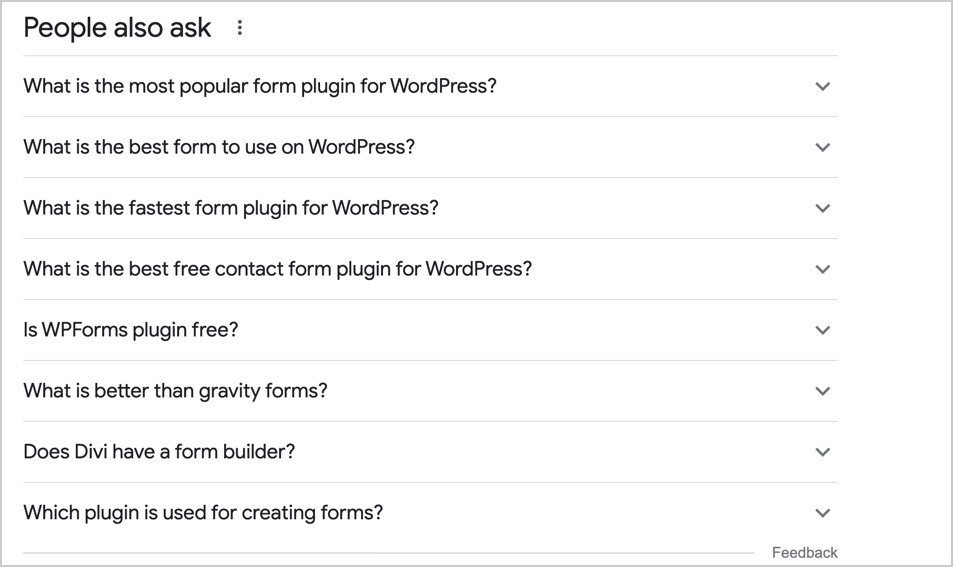

Additional Terms
Now, scroll past the People Also Ask section to the bottom of “page 1” of search results. Take a quick look at the terms shaded in grey.


Decide if you’d like to address any of these topics in your article.
Now, remember our example of the search for “40-piece socket set on sale?” That keyword, like “best WordPress form plugins,” signals buying intent.
Wouldn’t it be nice if you could find relevant keywords that signal buying intent? What if you could find keywords with buying intent that are easy to rank for?
You could target those keywords with content and attract an audience ready to buy.
This is where keyword research tools come in.
Using Keyword Research Tools to Identify Search Intent
Enter a keyword into Semrush, and you’ll discover the intent behind it. Semrush is one of the best Keyword research tools that will help you identify search intent.
Semrush labels each keyword you enter with 1 of 4 possible search intents.
4 Types of Search Intent
The 4 search intents are Informational, Navigational, Commercial, and Transactional. Let’s learn individually what they mean.
- Informational Intent
Keywords labeled “Informational” signal the user wants to learn about or research a topic. They’re not looking for a specific website and don’t have buying intent.
When targeting such queries, content creators should focus on informing and teaching rather than selling.
Examples of informational search queries include:
- “what is the best exercise for a torn meniscus”
- “how long does it take to recover from flu”
- “what causes the seasons on earth”
- “who was genghis khan”
- “how to learn AI”
- “prevent frozen pipes”
- Navigational Intent
Navigational keywords indicate the user is trying to reach a specific website or webpage. Since these queries typically include brand names, ensure your site ranks well for your brand name and top product/service names. Ranking well for navigational queries targeting your business can drive traffic and conversions.
Navigational searches convert at a very high rate since they indicate the person has already decided where they want to go.
Examples of navigational queries include:
- “walmart login page”
- “starlink internet”
- “lego robotics kits”
- “home depot truck rental”
- “aioseo analyzer”
- Commercial Intent
Commercial keywords signal the user has some buying intent but needs more information before making a final decision.
When targeting commercial keywords, help searchers compare product features and prices. Help them understand what problems your solution solves and why it’s best.
Examples of commercial keywords include:
- “men’s leather bomber jacket”
- “best seo plugins”
- “docusign vs pandadoc”
- Transactional Intent
Transactional keywords signal the searcher is on the brink of buying or taking other action.
These keywords may include detailed product attributes or actions like buy, book, register, download, or subscribe.
Examples of transactional keywords include:
- “usa made m65 field jacket”
- “flooring stores near me”
- “learn to knit kits”
- “where to buy used cars”
When you target transactional keywords, be sure your related page(s) have a clear call-to-action (CTA). And make it easy for visitors to complete their goals, whether it’s checking out or signing up for something.
Keywords That are Easy to Rank For
Remember, we said wouldn’t it be nice if you could find keywords that signal buying intent (i.e., Commercial or Transactional keywords) that are also easy to rank for?
Let’s get to the “easy” part.
To research a keyword, enter your topic into Semrush’s Keyword Overview.
You’ll immediately see a Keyword Difficulty score for that keyword. The numerical score is displayed as a percentage but measured on a logarithmic scale. So, a keyword that scores 50 may be challenging to rank for.
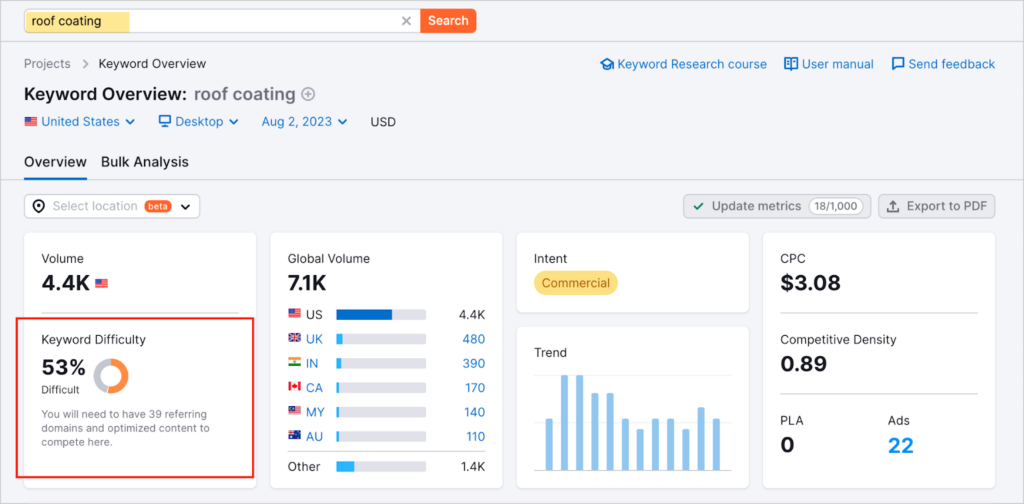

That may not seem intuitive, so pay attention instead to the keyword difficulty labels. Beneath each score, you’ll see a label like “Very hard” or “Very easy.”
If your website is new or you’re not ranking for much, we recommend only tackling keywords labeled “Very easy” or “Easy.”
Tip: If your initial keyword turns out to be difficult to rank for, click the Keyword Magic button in Semrush to get a list of related keywords.
Learn more about choosing keywords in Keyword Difficulty in SEO: What Is It and How to Use It.
Optimize Your Content for SEO
Once you’ve created high-quality content that matches search intent, the final step is to optimize it before publishing.
This is where a plugin like All in One SEO (AIOSEO) comes in. All in One SEO automatically analyzes your page and shows you how to improve it.
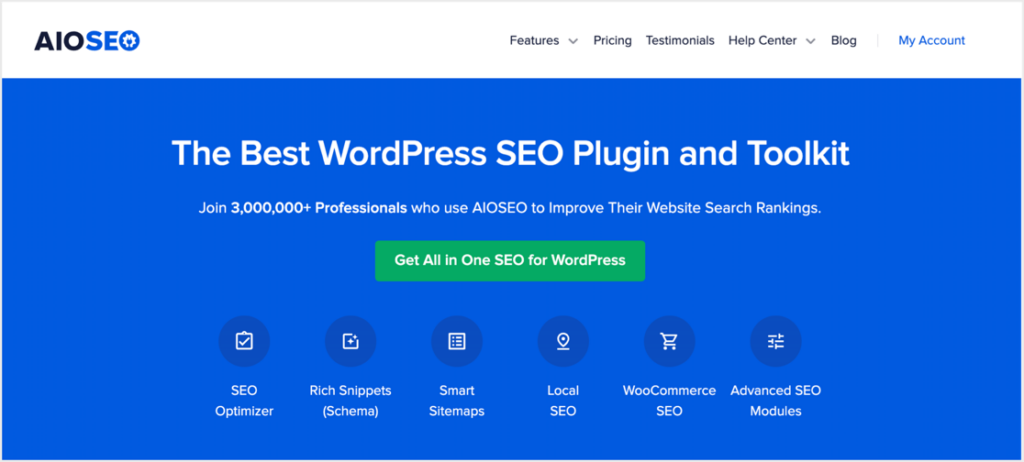

The plugin will also analyze your use of your focus keyword. Specifically, AIOSEO will look to see that you’ve used your focus keyword in several places, including in your:
- Title
- Page description
- First paragraph
- URL
- Some subheadings
- At least 1 image alt text (if relevant)
This is particularly helpful regarding ranking for the keyword you chose.
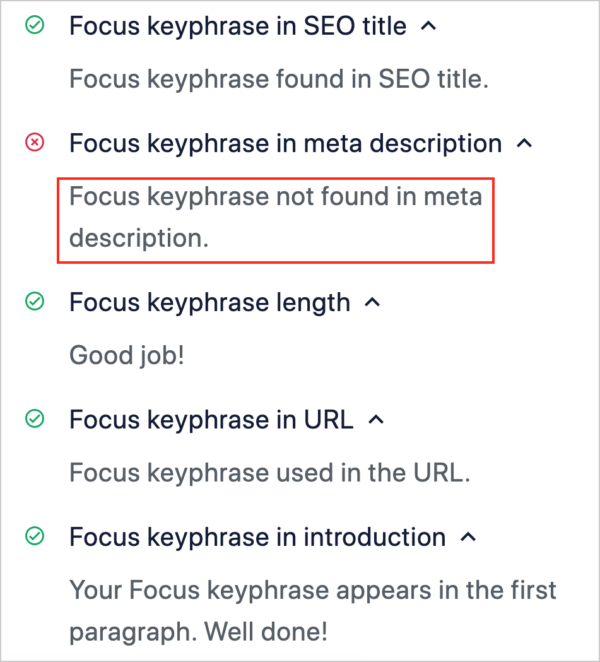

You’ll also get an SEO score for the page. You’ll see your score increase as you act on the plugin’s recommendations.
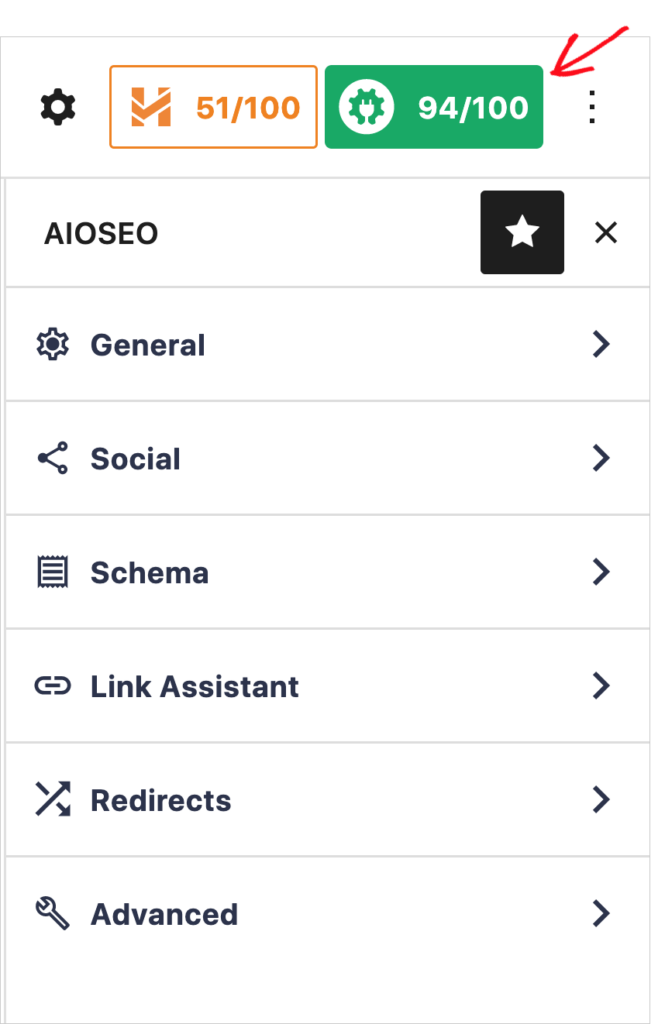

This helps you learn SEO quickly and removes much guesswork from ranking.
Some of the most popular features of AIOSEO are:
- TruSEO: See what needs to be changed on your web pages. TruSEO will analyze your focus keyword (target keyword) use, title and description, formatting, readability, and more. Then, it will provide a checklist with actions to take.
- SEO Analysis: Use AIOSEO’s SEO Analysis tool to get recommendations for your homepage SEO.
- Schema Generator: Easily add schema markup to your pages to help Google understand and rank your content.
- AI-Powered Link Assistant: Speed up internal linking to help your most important pages rank higher.
- Search Statistics: See which keywords you rank for without leaving the WordPress editor. (Only in the Elite version of AIOSEO.)
All in One SEO is an established plugin with thousands of 5-star reviews on WordPress.org. Currently, over 3 million people use the plugin.
[Need a website or landing page? Consider SeedProd. This WordPress page builder offers templates that are designed to load fast.]
Q&A on Search Intent
What are the 4 types of search intent?
The 4 types of search intent derive from labels created by Semrush, a keyword research tool. The 4 types are Informational, Navigational, Commercial, and Transactional. Keywords entered into Semrush are matched to an intent.
In Semrush, a keyword can be labeled with 2 intents, such as Navigational and Transactional.
How do you calculate search intent?
To discern search intent, refer to the keyword and the first 1 or 2 pages of search engine results. Keyword research tools like Ahrefs and Semrush can infer intent from a keyword, but search engine results pages are key in this process.
After Search Intent
Now that you understand search intent and can glean it from keywords and search engine results pages, what’s next?
Dive deeper into the topic by finding low-competition keywords that drive conversions. And learn the SEO secrets the pros use to grow revenue.
Find new opportunities for learning on our YouTube Channel. And follow us on X (Twitter), LinkedIn, or Facebook to stay in the loop.


